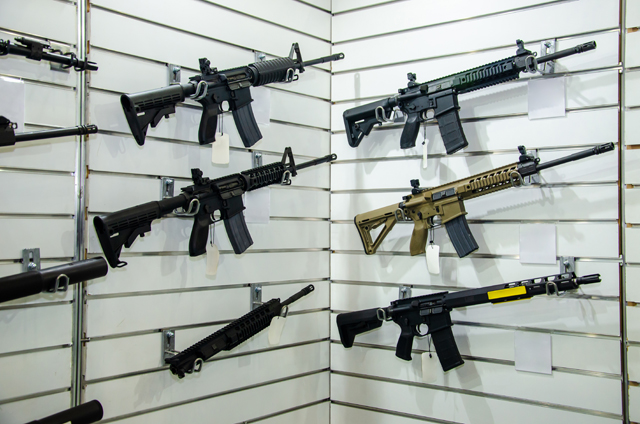
Many Firearm Buyers and Sellers do not Comply with Assault Weapons Bans
New UC San Diego research suggests that gun laws would gain more compliance if they were enforced
Published Date
By:
- Christine Clark
Share This:
Article Content
With the number of mass killings by firearms rapidly increasing from 270 in 2014 to 693 in 2021, President Biden recently called for the reinstatement of the federal assault weapons ban as a way to curtail gun violence. But how effective are weapons bans and will the market comply with them? For decades, the issue has been understudied due to unreliable data, but new research from the University of California San Diego’s Rady School of Management provides insights into what might happen if new federal assault weapon restrictions were put into place.
A paper to be published in the March issue of the Journal of Empirical Legal Studies assessed the impacts of the 2016 Massachusetts Assault Weapons Ban Enforcement Notice. Massachusetts Attorney General Maura Healey issued the Enforcement Notice to clarify that new sales of AR-style rifles—millions of which had been sold in the state—would be considered illegal under the state’s Assault Weapons Ban.
Unique to the UC San Diego study is its analysis of data on firearm sales and licenses, which are difficult to obtain in jurisdictions across the country. The paper finds that within five days of the Massachusetts Enforcement Notice’s announcement, assault rifle sales increased by 560 percent (up by 1,349). However, they were 64 to 66 percent lower in 2017 than in comparable earlier periods, indicating that the Enforcement Notice reduced assault weapon sales in the long run, but also that many banned weapons continued to be sold. In Massachusetts, similar to laws in Washington and Colorado, compliance from gun dealers and manufacturers is voluntary with no recourse from law enforcement officials with respect to prohibited weapons.
“Our research suggests new firearm restrictions require enforcement to gain full compliance,” said Kenneth C. Wilbur, professor of marketing and analytics at the Rady School and co-author of the study. “If the market complied fully with the Enforcement Notice, then assault rifle sales should have been zero in 2017. The data clearly show that not all firearm sellers and buyers complied with firearm restrictions. In fact, they directly reported their own noncompliance to the state government.”
Wilbur and co-author Meenakshi Balakrishna, a PhD candidate in quantitative marketing at Rady, point out that the Enforcement Notice was intended to close an important loophole in the initial Massachusetts assault weapons ban first instated in 1998. It outlawed copies or duplicates of banned assault rifles that facilitate rapid firing and rapid reloading, such as the Colt AR-15 and the Kalishnikov AK-47.
“After the 1994 federal assault weapon ban was enacted, gun manufacturers quickly introduced minor variations on the specific firearm products named in the ban, thereby apparently skirting the ‘copies and duplicates’ restriction,” Wilbur and Balakrishna write. “AR-style rifles today are extremely popular—an estimated 1 to 2 million AR-style rifles were manufactured in 2016 with up to 15 million in circulation.”
Another important takeaway from the Massachusetts law, which was announced by the state’s Attorney General seemingly without warning, nor debate, was how it immediately prompted a spike in sales of the very guns it outlawed. “The Massachusetts Enforcement Notice was seen as a surprise,” Wilbur said. “Our research suggests that if a politician or a regulatory body wants to restrict weapons, they should design both their policy changes and their communications about their policy changes very carefully.”
He added, “We see a direct correspondence in increased gun sales following mass shootings. Most of that is probably driven by purchaser concern about new weapon restrictions. Manufacturers both benefit from those concerns and actively promote them. Policymakers also need to be proactive in communicating their message on the topic clearly to constituents.”
This research also has implications for firearm data collection and provision. The data for the study were obtained through the authors filing a Freedom of Information Act request with the Massachusetts Department of Criminal Justice Information Services. However, they note this information could be made public while preserving privacy information.
The study was made possible because the Massachusetts Department of Criminal Justice complied with the public records requests. Similar requests were filed in California. However, the state’s information services department did not comply with the academic researchers’ request for more detailed access to the state’s aggregated firearm registration data.
“More and better scientific analyses will become possible if more jurisdictions collect and disseminate privacy-compliant firearm sales data,” they said. “This can be done at the state, county, city or even retailer level. Just as data on the spread of COVID has been critical to shaping policies during the pandemic, we need more and better firearm research if we hope to have evidence-based firearm policy.”
Share This:
You May Also Like
Stay in the Know
Keep up with all the latest from UC San Diego. Subscribe to the newsletter today.



